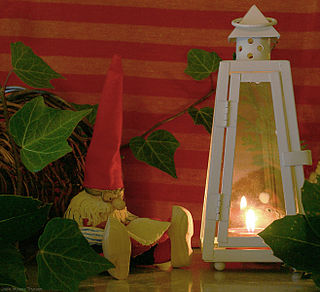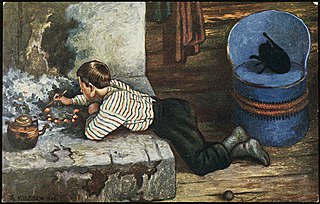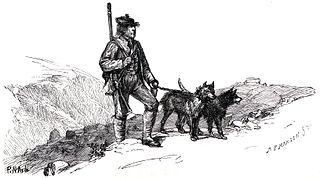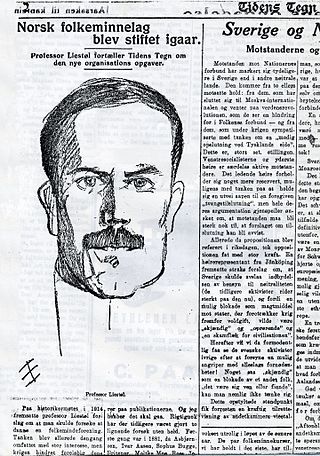
A troll is a being in Nordic folklore, including Norse mythology. In Old Norse sources, beings described as trolls dwell in isolated areas of rocks, mountains, or caves, live together in small family units, and are rarely helpful to human beings.

A nisse, tomte, tomtenisse, or tonttu is a mythological creature from Nordic folklore today typically associated with the winter solstice and the Christmas season. They are generally described as being short, having a long white beard, and wearing a conical or knit cap in gray, red or some other bright colour. They often have an appearance somewhat similar to that of a garden gnome.
In Scandinavian folklore, the mylingar were the phantasmal incarnations of the souls of children that had been forced to roam the earth until they could persuade someone to bury them properly.

A wight is a being or thing. This general meaning is shared by cognate terms in Germanic languages, however the usage of the term varies greatly over time and between regions. In Old English, it could refer to anything in existence, with more specific usages arising in Middle English, perhaps due to the term of similar meaning in Anglo-Norman, creature. The term is widely used in modern fantasy, often to mean specifically a being which is undead.
Nordic folklore is the folklore of Denmark, Norway, Sweden, Iceland and the Faroe Islands. It has common roots with, and has been under mutual influence with, folklore in England, Germany, the Low Countries, the Baltic countries, Finland and Sápmi. Folklore is a concept encompassing expressive traditions of a particular culture or group. The peoples of Scandinavia are heterogenous, as are the oral genres and material culture that has been common in their lands. However, there are some commonalities across Scandinavian folkloric traditions, among them a common ground in elements from Norse mythology as well as Christian conceptions of the world.

Tanngrisnir and Tanngnjóstr are the goats who pull the chariot of the god Thor in Norse mythology. They are attested in the Poetic Edda, compiled in the 13th century from earlier traditional sources, and the Prose Edda, written by Snorri Sturluson in the 13th century.

Ashlad is a main character in a number of tales collected in Asbjørnsen and Moe's Norwegian Folktales.
Tatterhood is a Norwegian fairy tale collected by Peter Christen Asbjørnsen and Jørgen Moe.
"About Ash Lad, Who Stole the Troll's Silver Ducks, Coverlet, and Golden Harp" is a Norwegian folktale collected by Peter Christen Asbjørnsen and Jørgen Moe in Norwegian Folktales, translated as "Boots and the Troll" by George Webbe Dasent in 1859.
Vardøger, also known as vardyvle or vardyger, is a spirit predecessor in Scandinavian folklore.

Anne Olsdotter Godlid was a well-known Norwegian storyteller from Seljord, Telemark, Norway. She was noted for her excellent memory and proved an invaluable resource for collectors and Jørgen Moe, Magnus Brostrup Landstad, and Olea Crøger.

Fuligo septica is a species of slime mold in the class Myxomycetes. It is commonly known as scrambled egg slime or flowers of tan because of its peculiar yellowish appearance. It is also known as dog vomit slime mold or Jasmine mold and is relatively common with a worldwide distribution, often being found on bark mulch in urban areas after heavy rain or excessive watering. Their spores are produced on or in aerial sporangia and are spread by wind.
The Bøyg, also referred to as the "Great Bøyg of Etnedal" is a legendary gnome-like creature in Scandinavian folklore.

Per Gynt is a Norwegian fairy-tale which originated in the traditional region of Gudbrandsdal.
The tilberi (carrier) or snakkur (spindle) is a creature of Icelandic folklore, created by witches to steal milk. Only women can create and own them.

Moltke Moe was a Norwegian folklorist.

Norsk folkeminnelag (NFL) [= Norwegian Folklore Society] founded in 1920, is a voluntary, non-profit cultural organization communicating and disseminating traditional folk poetry and customs. Society protects collected materials through book releases, guides collectors, and own research in the field of folklore. From 1922 to 2012, the company has published 166 book titles, as well as a reprint of Magnus Brostrup Landstads Norske Folkeviser from 1852, besides cassettes and CDs with original recorded Folk Songs.
In Scandinavian mythology, the hug is an individual's mental life, in some contrast to the soul, a term which carries more spiritual connotations. Scandinavian languages each have a separate word for the soul that is a cognate with "soul" in English. Hug is specifically the Norwegian spelling of the word; it is rendered in Danish as hu and in Swedish as håg.
Reidar Thoralf Christiansen was a Norwegian folklorist, archivist of the Norwegian Folklore Collection (NFS) and professor of folkloristics at the University of Oslo.











